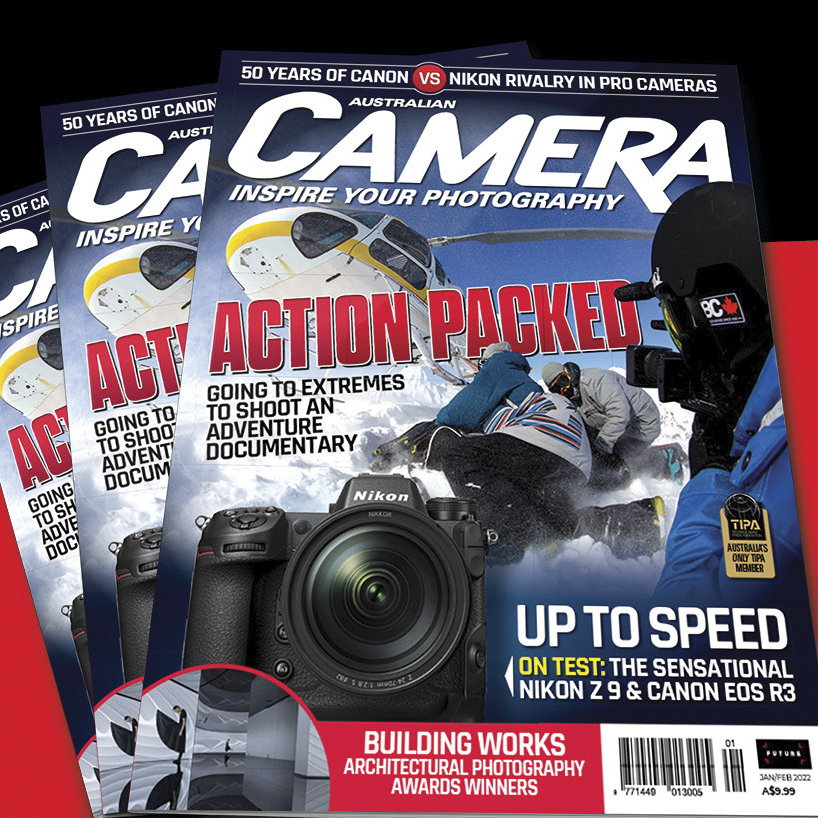Digital Camera World Verdict
It’s not specifically designed for photo printing, but dye-based inks on gloss media have always been a great combination and the ET-4500 delivers a snappy result. Long-term economics are the big attraction, if you aren’t chasing exhibition quality.
Pros
- +
Economical for volume printers
- +
Multi-function capabilities
- +
Great for photobook projects
Cons
- -
Average print longevity
- -
A4 size is the maximum
- -
Expensive initial outlay
Why you can trust Digital Camera World
Epson’s EcoTank inkjet printers reverse the customary printer/ink strategy. Small and expensive cartridges are replaced by a continuous ink supply from much bigger user-filled tanks, but the initial purchase price of the printer goes up. Apart from offering a new approach, a prime objective must be to make a sizeable dent in the sale of generic inks in the form of disposable compatible cartridges, refill cartridges or continuous bulk ink systems.
The EcoTank printers’ continuous ink system is not a new concept. Bulk ink supplies linked to replacement cartridges have existed as ‘alternatives’ to genuine ink cartridges for some time. They are promoted as “continuous”, but do require reset procedures when ink levels expire. Epson’s system is truly continuous and is direct to the print head without intermediate cartridges, while anti-clogging devices prevent tube blockages and stop any air bubbles reaching the print heads.
Another important difference is image longevity. At 18 years for prints under glass, the Epson EcoTank inks are not exactly ‘long life’, but are far more durable than third-party inks whose suppliers don’t dare mention ink ratings
Epson promotes the EcoTank printers as a general home or small business devices, and suggests that they’re not for everyone, least of all photographers who want the image quality benefits of having six colours or more, print longevity and plenty of control in the print panels. Even so, and despite the limitations, some worthwhile results were achieved, suggesting that these all-in-one printers, at least the higher-end models, do have photographic capabilities.
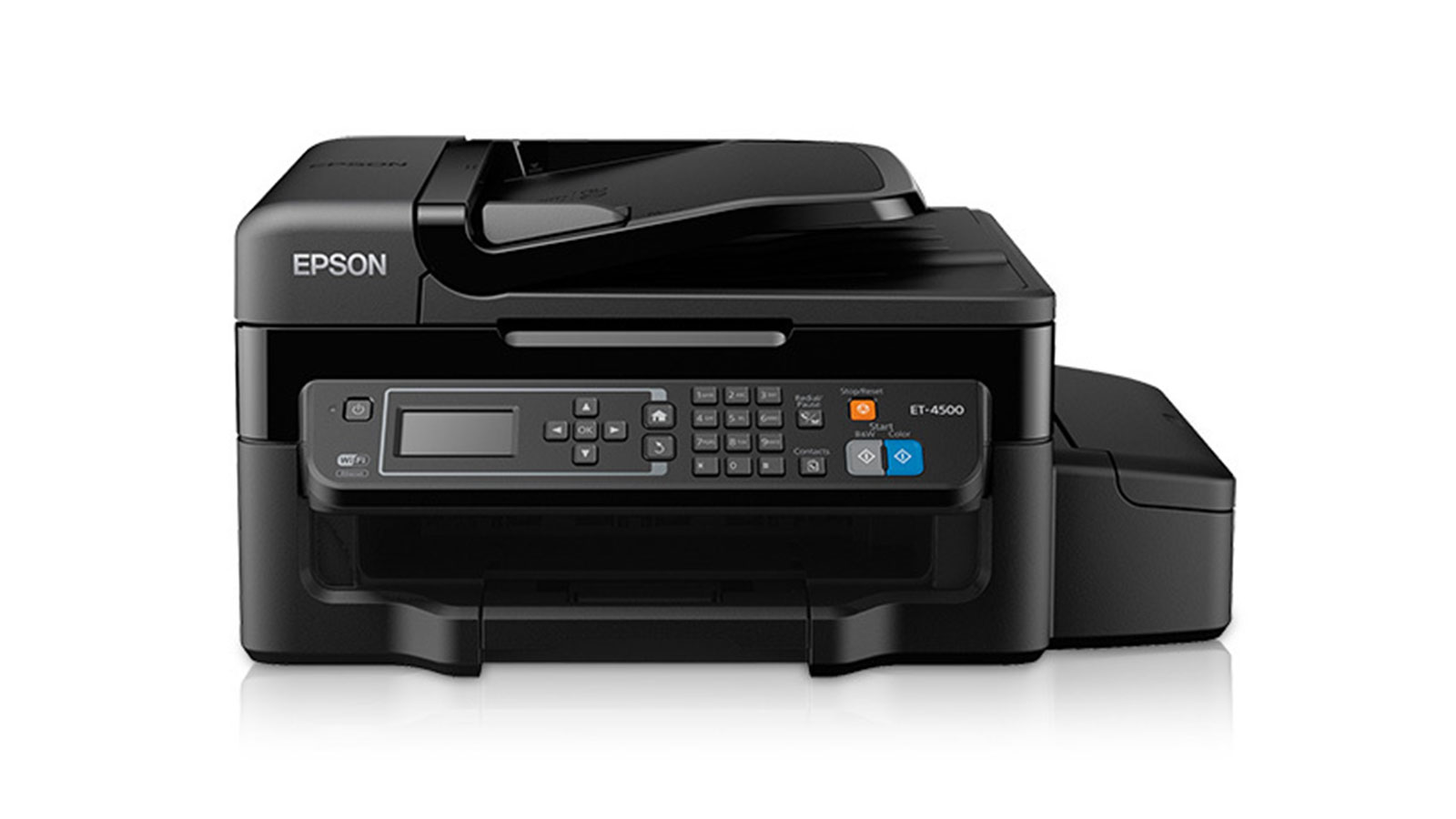
Description
There are currently four models in the EcoTank line-up, called the Expression ET-2500, Expression ET-2550, WorkForce ET-4500 and WorkForce ET-4550. This review is of the ET-4500 which is not quite top-of-the-line, but is better specced than the Expression models and is certainly well enough featured for the home office user who is also a photographer.
In appearance, the ET-4500 is business-like black all over. At only 6.4 kilograms in weight, it has a light weight plastic construction yet appears sturdy enough. Given the ink supplied is said to last two years with average usage, obviously the printer itself has to be built to last longer than this… one of the reasons for the higher purchase price compared to comparable ‘conventional’ models.
On the printer’s top is a 30-page auto document feeder (ADF) for paper to be used for photo copying and, directly under, is the receiving area. The ADF doesn’t handle auto duplex copying. This entire assembly lifts up to reveal the A4 format document scanning platform. At the rear is the two-section paper stacker tray and, at front right, at the base is the single-section pull-out receiving tray with lift-up flap to stop paper from heading straight to the floor.
On the right-hand side is the chamber for the ink tanks, with its single flip-up lid for all four reservoirs. At front and angled down is the control panel with a 5.6 cm mono LCD screen, numeric keypad and extra buttons (Redial/Pause, Contacts, Stop/Reset and Start, B&W and Colour).
All manner of connections are available for both cable-linked (USB, Ethernet), networked and Wi-Fi remote devices (Wi-Fi, Epson Connect, Epson Email Print, Epson iPrint Mobile App, Epson Remote Print, Apple Air Print and Google Cloud Print). A fax capacity is also included.
With the EcoTank system there is the equivalent of about 20 14 millilitres cartridges, sufficient to run up to 4000 pages in black and 6500 pages in colour. As the ink reaches the print head via tubes there are no cartridges riding alone on top of the print head, thereby reducing wear and delivering a smoother action. The four inks – magenta, cyan, yellow and black - have a T664 coding. Ink levels may be viewed from the ‘Main’ panel or by simply looking at the side of the translucent ink tanks.
The 70 millilitres ink bottles are priced at AU$16.99, which brings the cost per millilitre down to just 23 cents. When compared to, typically, about $2 per millilitres with conventional ink cartridges, the savings are significant. However, this really doesn’t start to take effect in an overall sense until replacement bottles are introduced.
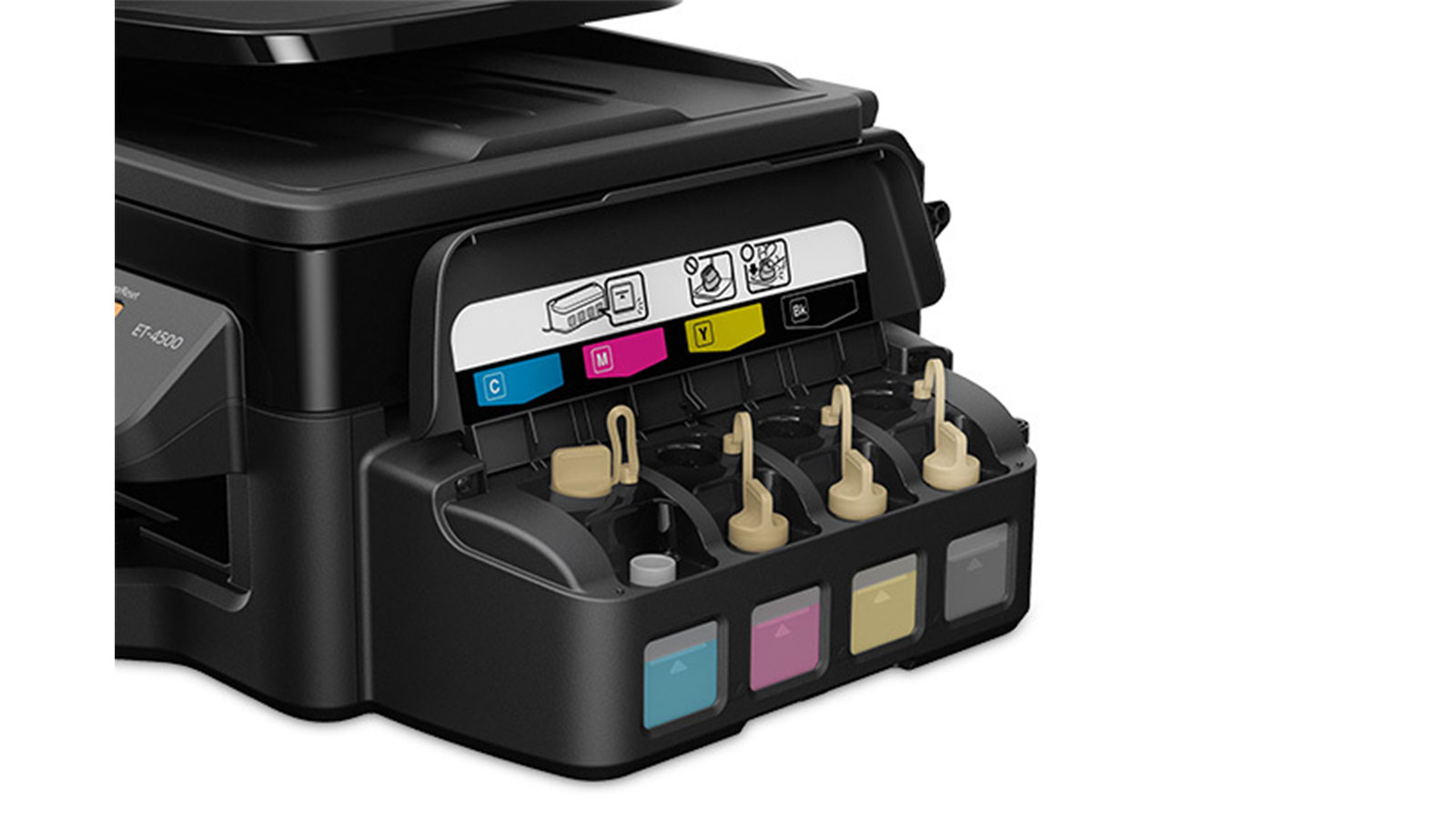
The realities
The high number of pages that the EcoTank printer can produce seems mighty appealing, but for printing photographs we need to put everything into perspective. A 4000-page rating refers to only about five percent coverage of text. If an A4 photo print consumes about 0.7 millilitres of ink then that total of 280 millilitres of ink represents about 400 prints. Of course, this is still an appreciable number of prints.
Cost comparisons are not easy to make when printers and inks vary considerably in price, not to mention those occasional specials. In order to put everything into perspective, some assumptions are required. If a basic four-colour printer costs around AU$80 and its cartridges each contain about ten millilitres of ink, then a calculation can be made to see how the ink costs square off against the EcoTank model. In order for that to happen, the AU$80 printer needs another 240 millilitres of ink… or another 24 cartridges. At about AU$15 per cartridge this works out at AU$360. The Epson ET-4500 costs AU$449 for its 280 millilitres of ink while the AU$80 printer plus a pile of cartridges has cost AU$440.
From there onwards though, the EcoTank printer wins handsomely. For example, in environmental terms, 28 spent cartridges go to landfill with the conventional printer – or just four 70 millilitres ink bottles. It’s also likely that the cheap printer will end up in landfill quite a number of years before the EcoTank model, which will probably outlast several replacements.
All things considered, though, the prime difference is the sheer convenience of the EcoTank printer with its true continuous printing.
The choice between an inexpensive multi-functional with conventional cartridges (i.e. the Epson WF-2630 at AU$99, the XP-200 at AU$55, or even down to a printer selling for a paltry $28.88 – all from one major retailer in Australia) and the EcoTank system will be mostly based on expected print volumes over a year or so. The EcoTank printer is not a machine for casual five print-outs or so a week usage. That does warrant the cheap printer and inexpensive replacement cartridges. To reap the benefits of an EcoTank printer, it needs to be worked regularly and here is where its benefits in the office, the club and the homework environments stand out. Larger organisations would find the likes of the ET-4500 too slow and limited in paper capacity and would look to something like the WorkForce Pro-WF-R series.
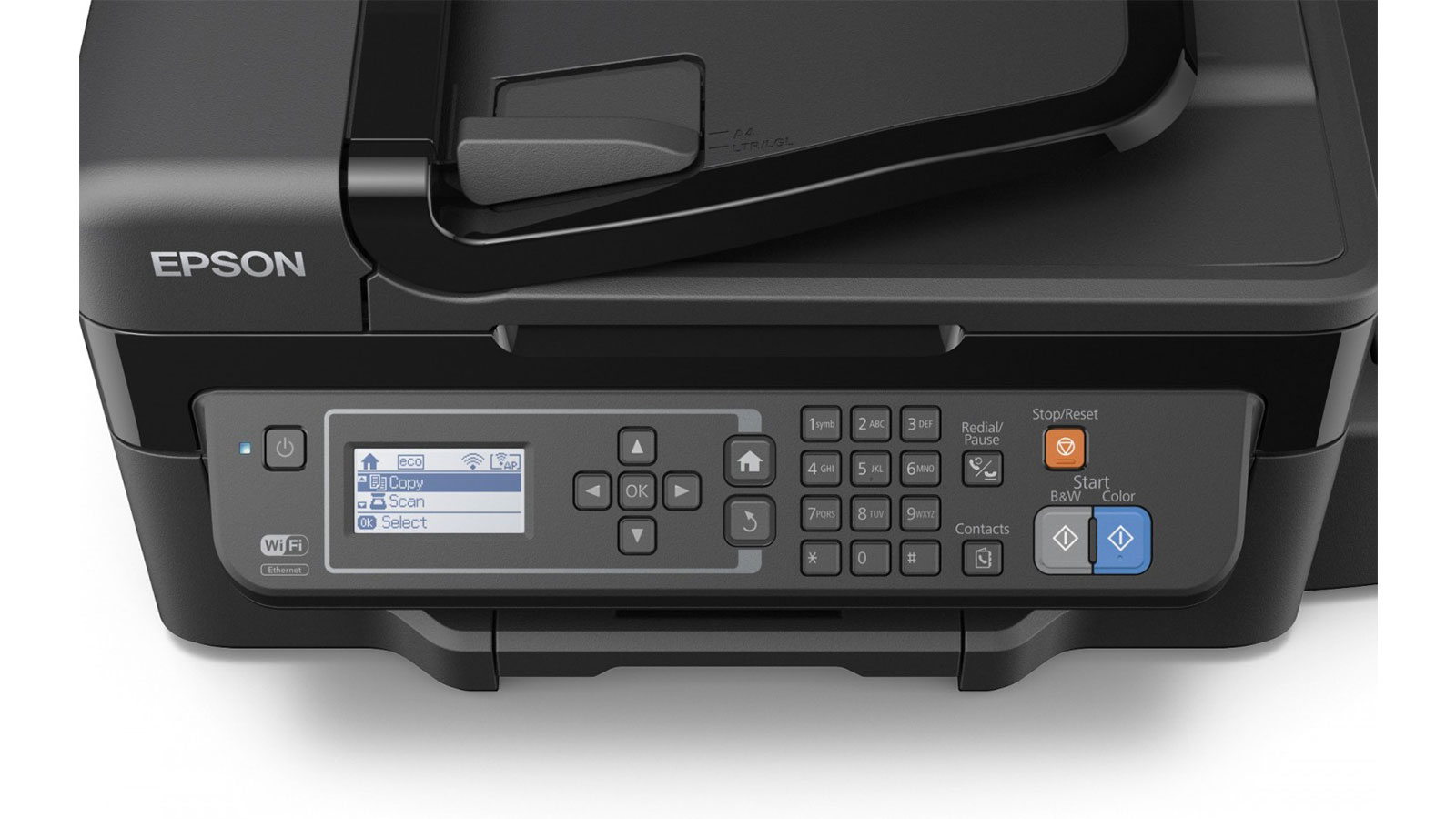
Printing photos
Not surprisingly, photo enthusiasts will be keen to see what the EcoTank printer can achieve in photographic output. Although photo printing is not a promoted feature of any of these models, the news is that good results can be achieved. However, it all relates to using inkjet papers, so any thoughts of perhaps using plain paper for this should be dismissed.
Dye-based inks on gloss media have always been a great combination, and even the four colours of the ET-4500 turn out a snappy result. Overall, prints lack the tonal scale and subtleties of a six-ink (or more) system, which is to be expected, but nevertheless if print files are well organised the prints are pleasing.
The ‘Automatic’ approach to printing with either Epson Matte or Epson Premier Gloss papers will provide accurate results. When other Epson surfaces like lustre (or other brands) are involved, either the ‘Epson Matte’ or ‘Epson Premium Gloss’ paper types must be selected. Epson lustre paper, for example, simply takes up the ‘Premium Gloss’ option.
Overall adjustments can at least be made to colour (i.e. cyan, magenta, yellow), brightness, contrast, saturation and density. When a revised set of characteristics is established, everything may be saved and added to the ‘Preset’ listing for future use. For example, a 190 gsm dual-sided gloss paper produced a dark and reddish print when made in ‘Automatic’. The same result occurred in ‘Custom’ with the ‘Adobe RGB’ colour mode, but at least in the ‘More Options’ panel the necessary corrections could be made. By reducing red by minus six in both yellow and magenta, and by increasing brightness by six, the result was a good screen match-up. These settings were then saved as “190 Gloss 2s”.
Since all my print files are in Adobe RGB and generally printed via Photoshop, I found the best approach was to start with the ‘Main’ panel and lock in the required ‘Document Size’, ‘Paper Type’, ‘Quality’, ‘Colour or Grayscale’ with ‘Print Preview’ selected, and then proceed to the ‘More Options’
panel and set ‘Media Mode’ to ‘Adobe RGB’. If you’re using sRGB files then ‘Custom’ and ‘PhotoEnhance’ are a good option, or simply go ‘Automatic’.
This printer clearly isn’t intended for use with fine-art papers, but we reviewers like to push boundaries. An A4 sheet of 315 gsm Innova Smooth Cotton was accepted by the printer and took a lengthy 7:10 minutes to print. Without any set profiles for the paper, the ‘Epson Matte’ setting was adopted at high quality and with high speed switched ‘Off’. Using a fine-art photo paper in a basic four-colour printer might seem like overkill, but the result was rather impressive and only reinforces the view that dyes on fine art media can be an excellent combination. It’s worth noting, though, that papers heavier than about 315 gsm will not be accepted by the ET-4500. But the capacity to still handle relatively heavy papers means that the likes of greeting and business cards are well within this printer’s capacity.
Because dyes exhibit short term colour drift, it is important to make assessments after prints have dried down. It’s equally important to make appraisals in decent lighting conditions. Comparing images on screen to hard copy via a small desk lamp is not the way to go.
A curious aspect of this printer is its ‘stop-and-go’ behaviour. During printing, for instance, it stops after about ten seconds, as if to catch its breath, and then carries on.
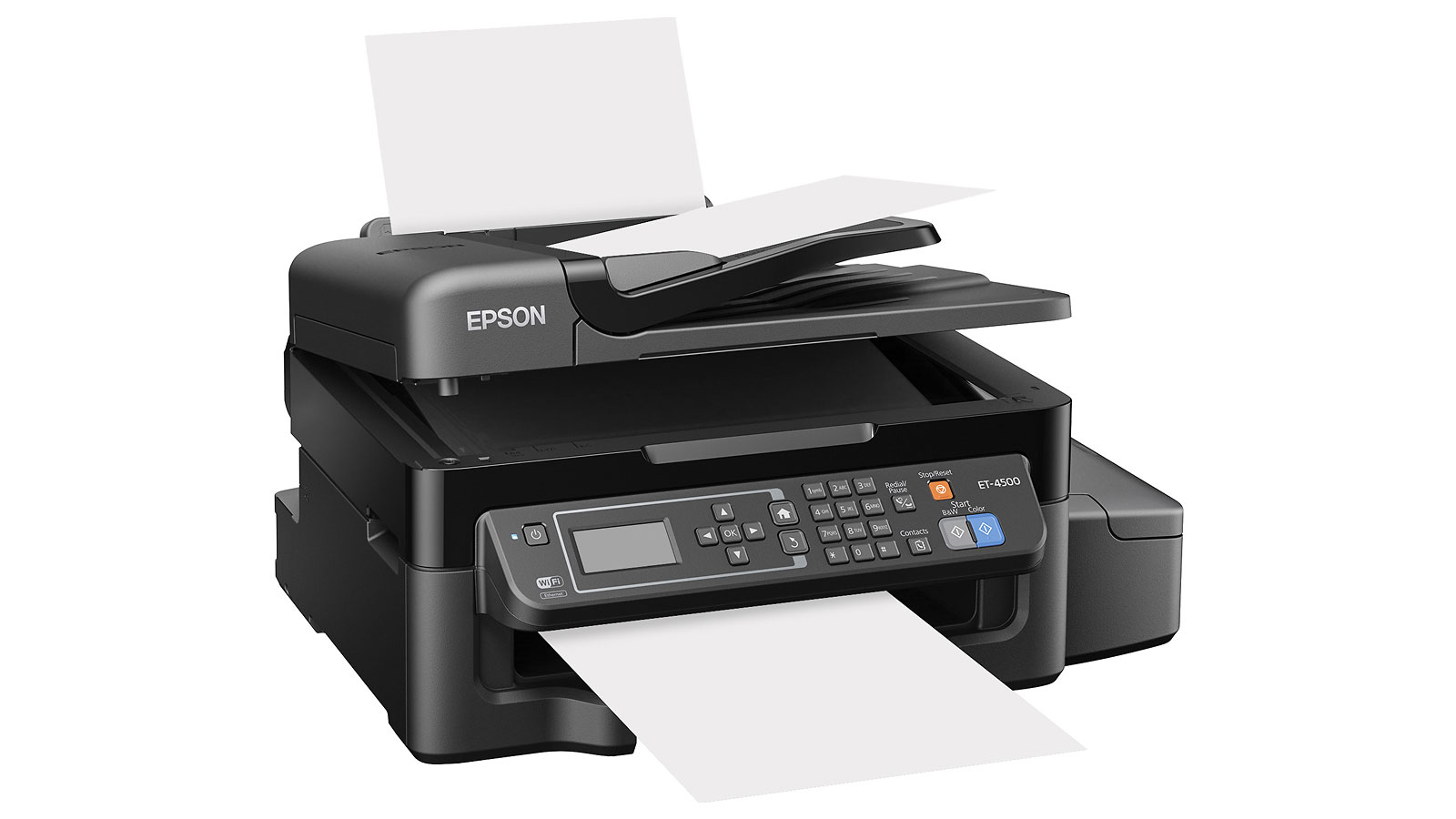
Black and white
Most four-colour inkjet printers use the full set to print black-and-white photographs with a resultant slight red cast. The ET-4500 is no exception. Opting for a deliberate colour cast, such as sepia, is a suggestion, but there is a way around the situation. If ‘Plain Paper’ is selected but photo paper used in conjunction with the maximum quality setting and with high speed printing switched ‘Off’, the printer basically resorts to using the black ink tank only, and produces a more neutral result.
Viewed under a magnifier, the print will appear to be grainier, but there is no red cast. The more prominent dot structure can create the illusion of a sharper image compared to printing to a photo paper profile. An A4 black-and-white print, made using this unorthodox approach, took 1:15 minutes to produce.
Print longevity
Epson has so far not provided any longevity ratings for the EcoTank printers, but we can make a fair assumption based on the figures for the L800 and L1800 models (which have been available in various overseas markets for a while). For these two printers Wilhelm Research has established a maximum rating of 18 years for prints under glass, but the dark storage results have yet to be finalised. Although these two printers use a six-colour ink system, it’s reasonable to assume the ink formation is similar.
A rating of 18 years is fairly low in comparison to other inkjet printers, least of all Epson’s own Claria inks as used in the Artisan printers which rate 98 years under glass and 200 years in dark storage. Of course, the EcoTank ratings far exceed those of third-party inks, but perhaps there are technical or marketing reasons why the Claria dye-based inks have not been considered for this application.
Verdict
The Epson ET-4500 and its EcoTank siblings are essentially document printers rather than photo printers, although they’re capable enough in all departments. Perhaps the key words for the Epson EcoTank printers are “convenience” and “usage”.
In many respects, the ET-4500 is an intermediate ‘just right’ solution for those people and organisations who churn out a fair volume of printing and occasionally have need to scan or photocopy documents. Infrequent or high-speed, high volume usages are probably best addressed with more appropriate printers.
Many enthusiasts might see the WorkForce ET-4500 (or another in the series) as being an economical approach to general multi-functional tasks, including A4 photo printing in conjunction with an existing or proposed dedicated A3+/A2 inkjet printer to handle display prints and work where image longevity is important.
In order to satisfy the needs of photographers, perhaps Epson Australia will introduce the L800 and L1800 models. The L1800 is the ‘real deal’ for photographers – with six inks, borderless printing and A3+ format (see Epson’s Websites for Singapore or Europe) or, better still, include the EcoTank system with the Claria inks from the Artisan 1430. That would address all the main criteria of quality, long print life and economic inks… and keep photographers very happy indeed.
So the Epson EcoTank printer represents a positive step in inkjet printing for the smaller format printers, but in doing so raises many questions. How will consumers and the manufacturers and distributors of compatible systems react, and will Canon and HP enter the field with their own alternatives? It will be interesting to see how everything pans out.
In the meantime the Epson EcoTank printers are here now with multi-functional features, the ability to produce a decent print and packaged with a generous ink supply and a different ethos.
Is this the start of a revolution in inkjet printing?
Read more:
Best large format printer for photographers, exhibitors and studios
Best portable printers for photos
Best photo printing online: top services from around the web
Best 3D printers
Australian Camera is the bi-monthly magazine for creative photographers, whatever their format or medium. Published since the 1970s, it's informative and entertaining content is compiled by experts in the field of digital and film photography ensuring its readers are kept up to speed with all the latest on the rapidly changing film/digital products, news and technologies. Whether its digital or film or digital and film Australian Camera magazine's primary focus is to help its readers choose and use the tools they need to create memorable images, and to enhance the skills that will make them better photographers. The magazine is edited by Paul Burrows, who has worked on the magazine since 1982.

